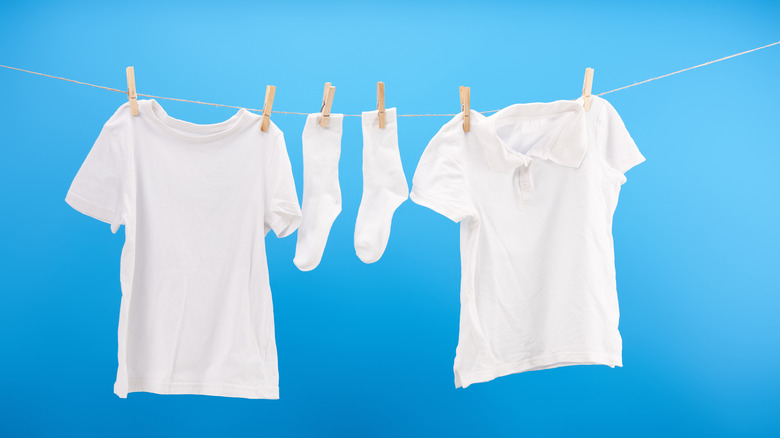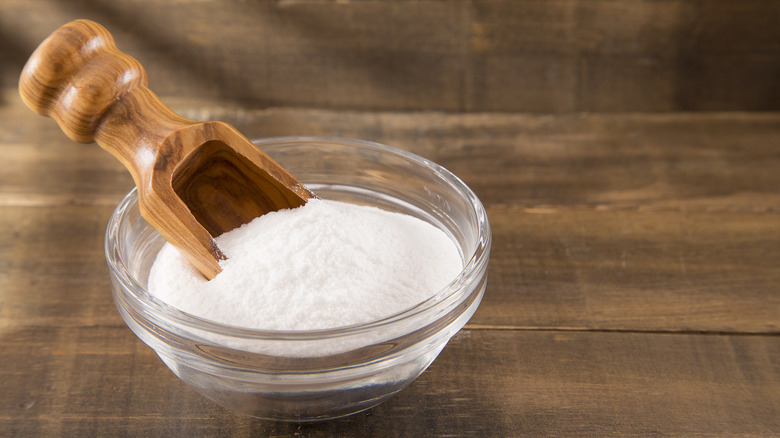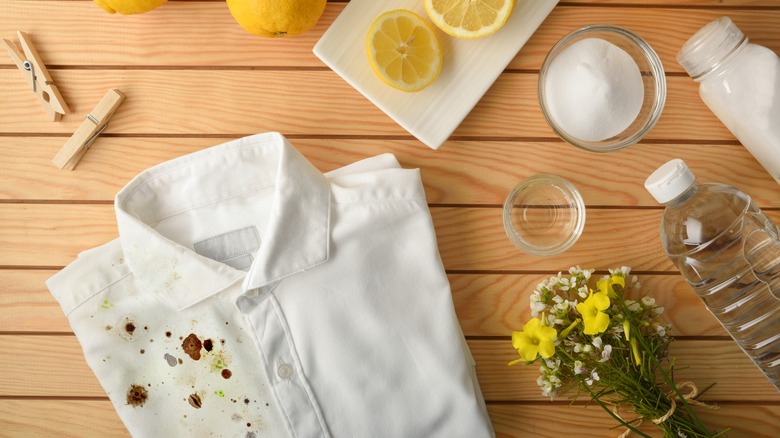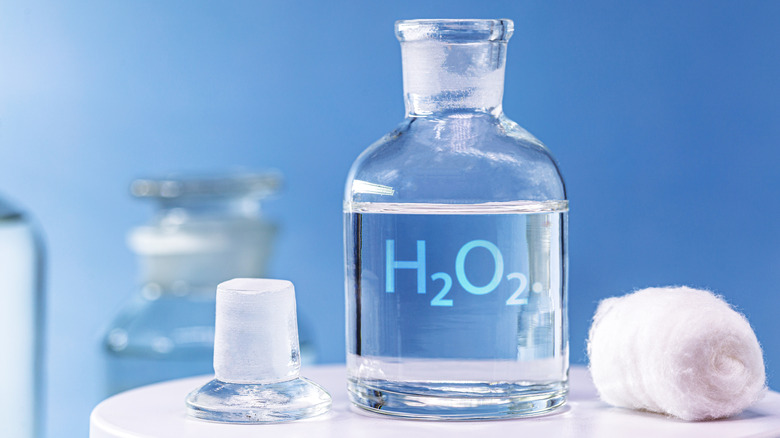Here's How To Brighten Your Whites Without Using Bleach
Getting pesky stains out of your white clothes can be a never-ending battle. Although chocolate, red wine, and strawberries are a delicious combination, they can be tough to get out of your whites if things get messy. That's why some people turn to the stain-busting power of bleach to eliminate those complicated stains. Bleach can be made up of a few main ingredients depending on the type you're using. For deeply set-in stains, some products have sodium hypochlorite, which works to eradicate the mess, disinfect, and make your whites even brighter, according to the American Cleaning Institute. However, when used on more natural fabrics such as wool and silk, it could ruin the material. If you're unsure whether items are safe to bleach, always check the washing instructions label before you commit to using it on your next load.
Though bleach is a popular way to keep your whites looking their most vibrant, the chemical can irritate the eyes, nose, and hands when in direct contact, as per the National Library of Medicine. If chlorine bleach is accidentally mixed with an ammonia-based cleaner, the fumes could be fatal. For those with sensitive skin or asthma, bleach can become very uncomfortable to use, even when diluted with water. So, some might reach out for other alternatives when making their laundry beam. Let's look at other ways to brighten your lights that don't involve bleach.
Baking soda
Baking soda can be a useful tool when it comes to lifting stains from your clothes or other light-colored laundry. A natural product, baking soda is made from sodium bicarbonate and can be bought for a low price at any grocery store. Although you can use it in baking some of your favorite desserts in the kitchen, its properties can also be beneficial in splitting down the molecules in greasy and dirty messes, making them easier to clean, according to Live Science. For instance, a simple mixture containing a 1/4 cup of water and about 4 tablespoons of baking soda can help to remove sweat or makeup stains from your shirt collar, as per Arm & Hammer. If it's larger sweat marks that are making a scene on your clothing or sheets, then create a type of paste using baking soda and little water, then work it into the stain with a small brush before washing the items.
Whereas a harsher bleach may eventually break down the gentile fabrics of your laundry, baking soda is a more natural ingredient that won't work against you. However, if you use it on colorful garments, make sure you do a test on a hidden part of the material to make sure that it won't ruin the look of the fabric. Also, ensure that all of the baking soda is washed thoroughly from the material you are cleaning; otherwise, it could cake onto the item and leave a chalky residue.
Vinegar
Vinegar is a versatile ingredient that can take stain-fighting to a whole new level, and when used as a laundry detergent, it can aid in breaking down certain molecules that are set in stains. When utilized to brighten your whites, vinegar can be the ideal substitute for bleach. After diluting it with some water to ease the harshness of the acid, the mixture can then be placed directly on the stain in question to help loosen the dirt and grime from the fabric. Or you can wash a whole load of laundry with a mixture of equal parts vinegar and lemon juice by adding it to the detergent compartment of your machine and running it through the cleaning cycle, according to Healthline.
However, vinegar's prowess in the laundry room doesn't stop at its ability to brighten whites. It can also aid in lifting soap buildup in clothes, act as a deodorizer, help to curb the fading of colorful garments, and keep your laundered items soft to the touch. All this while also having the benefit of being eco-friendly and hypoallergenic. Vinegar can be the perfect bleach substitute for those with sensitive skin, as the acidic properties are not strong enough to cause irritation when in close contact. Although vinegar has a unique pungent smell, users don't have to worry about that sour scent sticking to their laundry. When diluted and used for washing, the mixture should leave you with a clean, odorless, brighter-looking load.
Hydrogen peroxide
Oxygen bleach or hydrogen peroxide — which is in products such as Oxiclean — works to lift the molecules in the stained area and maintain the whiteness of your laundry. Although the chemical name sounds a bit frightening, when you break it down, H2O2 is simply water with a little extra oxygen (but still, don't ingest it). This extra oxygen helps to create a fizzy effect that takes out the dirt and grease from clothing as it quickly converts back to its water form, according to Greenopedia. Hydrogen peroxide is a fantastic alternative to bleach because it's more natural yet still affordable and has the same stain-busting properties as its chemically smelling counterpart.
For a natural bleach solution that's sure to take the stains out of your white fabrics, try this recipe from Going Zero Waste. First, squeeze all of the juice from one lemon into a large bucket. Next, add a couple of tablespoons of hydrogen peroxide combined with 1 tablespoon of Castile soap. Finally, pop in 1 gallon of hot water. Take the garments you need bleached — ensuring that they are safe to be bleached in the first place — and place them in the mixture. Let it sit for 15 minutes, then take a wooden spoon and stir the contents around. Afterward, allow it to soak for a few hours. Once the time is up, rinse the garments with cold water and place them to dry in the sun or your dryer.



